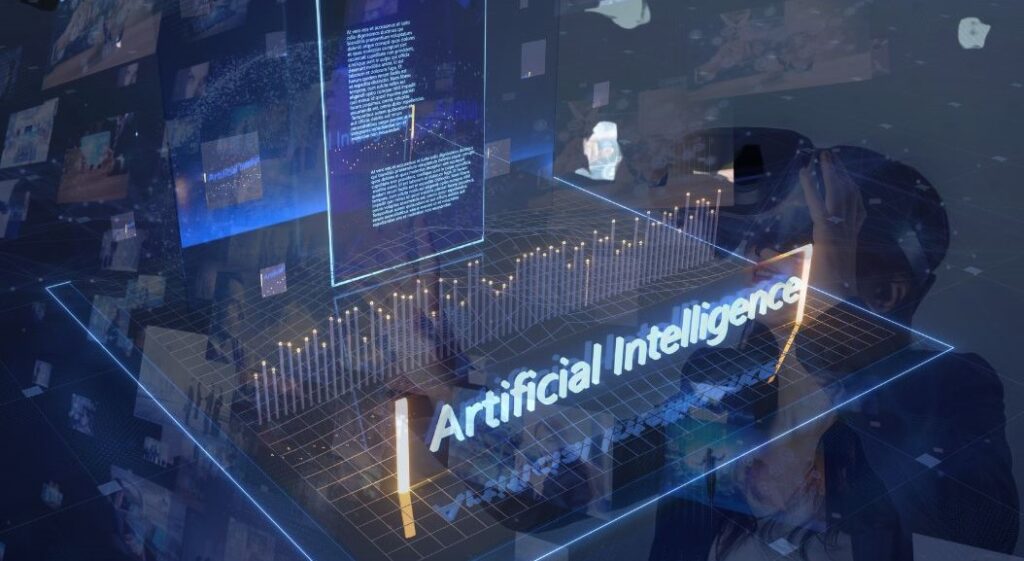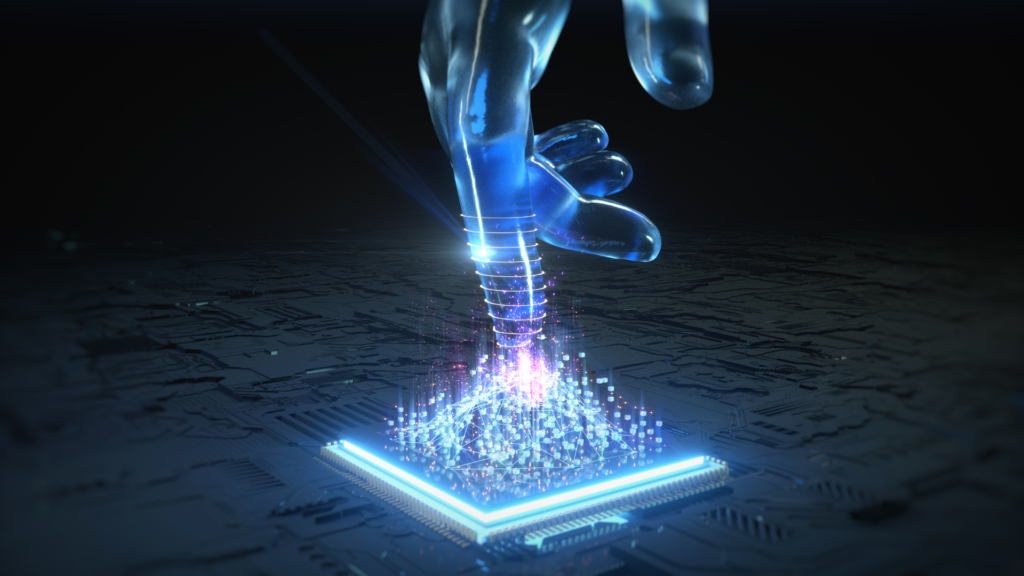AI has resided in our minds for decades now. But what if it was just a sort of distraction from what was coming? Is our future destined to reside with the next level of virtual reality(VR) – that’s Virtual Artificial Intelligence(VAI)?
We have realized Artificial Intelligence as on its way to our homes and workplaces. The internet is chock-full of articles proclaiming the imminent death of mankind at the cost of a few thousand lines of code.
From “Skynet” to George Orwell’s “1984”, we can’t seem to escape the doomsday drama that seems so popular right now.
We have plastered a concept about AI in our brains. We’ve also already accepted that it’s the only possible way it is going to be. That’s not a coincidence, it’s a form of confirmation bias. Maybe, there is something far more fascinating that is going to get unveiled.
What is that “something far more fascinating”?

Well, it’s Artificial Intelligence, but Virtual. Here, we are not even talking about something like a neural implant or a cortical implant. No, we are talking about the most exciting and yet the most subtle technology of them all, Virtual Reality.
Virtual Reality itself is a step further than AI. VR is not even a human invention, it’s an evolutionary technology. The innermost desire of every organism is to survive and thrive in any environment possible. That’s what drives evolution forward across species and time.
Artificial Intelligence is merely a child of this evolutionary drive, because, given our timeline of tech evolution, it was the first implementation that met the conditions for survivability in our thoughts.
Now, it’s time to take a step further and open up to “Virtual” survivability. It means preparing ourselves to survive in the imminent virtual reality of the next level.
In the age of digital technology, we have been creating so much data that it has begun to form a sort of collective memory, which we call the internet.
The internet is an ample infrastructure that allows us to create anything and everything in it. And because we are talking about virtual reality here, there is no need to limit ourselves to real-life data anymore, right? All this makes Virtual Reality a very exciting field where AI itself can be put on hold for a while.
Related Readings:
If you ask me what technologies are going to define this century, chances are I am going to say the next level of Virtual Reality – VAI.
The most interesting, and encouraging as well for further development, thing about VR is that we can create the conditions or environments we wish to explore.
With VR you can create any environment that you want to live in and find your solutions where necessary. We are safe and we can solve “virtual” problems with relative ease. With physical AI, you never know what will happen.
Virtual Artificial Intelligence(VAI) – The complete concept

The current form of Artificial Intelligence we have is digital AI. The one shown in “Terminator” and other Sci-fis is Physical Artificial Intelligence (less likely, more dangerous). The one we are talking about, which is the future, is Virtual Artificial Intelligence.
Virtual Artificial Intelligence is where a digital representation of the AI has been implanted in your brain (or any other part of the body) with an input link. The digital representation is then able to mimic almost every physical activity you could perform yourself.
Thus, it can create virtual simulations of reality that are accurate beyond human biological limitations. And therefore, we can use them as real environments for training and testing.
If this were to work marvelously well, it would be without a doubt the next step in all areas of life, from business and politics to acting and entertainment. We would all have our own personal “9-to-5” office (wherever you are at the time).
The term
Yes. Here, the term Virtual Artificial Intelligence(VAI) refers to an AI-powered human who has immense capabilities inside a virtual world. We can see this as a revolution over the current form of digital AI.
In virtual reality, VAI can potentially solve problems that our organic minds cannot even comprehend.
For example, we can create a simulated environment with all sorts of variables and test it to death. It means we can create VAIs, to whom we will task to solve a problem. They will also be able to conduct their own research. Consequently, they will produce much more accurate results than any human being.
Can you imagine the possibilities this opens up for every industry? VAIs will soon be our personal assistants and an extension of our brains. We will have the power of thousands of minds inside our heads, solving problems, creating knowledge, and developing new technologies at an exponentially faster pace than we could have ever possibly imagined before.
And here is the best part; Everything will look real!
We’re going to visit a couple of different worlds:
The world of “perfect” problem solving, where anything goes and you can think of any solution that you wish to implement. In this world, AI is at its best and can create amazing results compared to our organic minds.
There are no rules or limits in this world. And, everything is possible there, from flying cars to healing the sick or traveling across universes or galaxies. This world only exists inside your mind – so far! But with VAI, we can make it true!
Or The real world, where you can fly a plane but it has to follow some set rules and regulations. In this world, AI is still at its best and it can create amazing results compared to our organic minds. But the problem here is that there are always limitations or limits to certain things.
Some limitations are scientifically proven (like gravity) and others are formed by society’s standards (like flying cars). This world only exists inside your mind – at least until now! With virtual artificial intelligence, we can make it true!
What do we need to make this concept a reality?
First off, we need to create the digital representation of our AI (which was implanted in our mind) that can do all the physical actions we wish and then can be used to create a virtual environment.
The main ingredient for this is a Virtual Reality lens.
What about the rest of these things? Well, we need some new hardware to make this possible. The main one of course is an implantable computer device. It can read your brain’s thoughts and interpret them into commands for implementing those thoughts inside a virtual world.
You could describe it as a Brain-Machine Interface (BMI) or simply as “mind control”.
We also need to have a way to connect these two together, either through a wired connection or with the help of an advanced brain-wave translation system.
But it’s not that simple! We don’t just want to implant this technology in your head and then leave it there.
The next thing is immersion. We must be able to sense the virtual world just as well as the real one. This can be done with some excellent visual and audio technology. But it’s still not completely immersive yet.
Imagine a virtual world where you can sense temperature and touch sensations, to whatever degree possible. You could take a virtual stroll in the rain or even go on a skiing session without fear of freezing your hands off!
We need to feel everything that we could feel in our real life and every other sense as well. In these ways, we will be able to experience the virtual world just like it is reality.
The next thing we need is a physical space, of course. We will still need a physical environment to stay alive after all and this can be anything from a space station to a beautiful house on a tropical island or a human-sized box.
Artificial Intelligence is going to do the rest of the job: How?
- AI-powered brain chip simulates the world and connects to the Virtual Reality lens which then connects to your brain.
- All of a sudden we are immersed in a world that we can experience exactly like real life (complete with all of its senses), but there is no way to die physically! We can only be injured or killed in virtual reality, never in reality!
- We will use anti-gravity and many more things inside VR and travel faster than light speed, i.e. 300,000 kilometers per second (186,000 miles per second) through the “vacuum” of empty space. But, yes, we will manipulate time and live much longer inside the virtual world.
AI-powered chip? But how will that chip be made?
The creation of an AI-powered chip we are talking about is too complicated. It can be made, and we will be discussing the details here.
For the creation of such a chip, we will need a few things:
1) High-level AI computing power
An AI that can formulate complex ideas and decisions, in a very efficient way, like the human brain. (This is probably the most difficult part of the solution).
2) The simulation of SoC-AIP (System on a Chip Advanced Intelligence Processor)
This is an artificial brain that simulates synapses in the human brain for processing information. This is also very similar to neural networks that are used by our biological brains for thinking and learning. (Mostly related to point 1.)
3) A very compact computer system that can be implanted in humans
Ideally, it will have all of its parts as small in size as possible, so it can be placed inside a small room in your head. (Yes, this is still a relatively difficult part).
4) The interface with the human brain and a series of other elements that do not need any further explanation here
So, if you think you have everything at your disposal that is needed for creating such a chip, then let’s talk about how to use it.
First, we have to build the AI chip. So let’s talk about the second part of the solution.
We will continue to use a computer system that is adapted to be implanted in humans. The computer system we are talking about is a chip that consists of an advanced computer processing platform with a neural cortex chip and a visual filter installed inside it. This combination is then connected to an implantable Brain-Computer Interface (BCI).
This BCI has what people call a ‘non-invasive electrode array’, which reads your brain’s electrical signals while you are wearing the headset and then translates them into commands that you can use in this virtual world.
Let’s get back to the computer. The first part of the chip is a System on Chip Advanced Intelligence Processor (SoC-AIP).
How will it work?
So, how will the SoC-AIP actually work? Well, let’s think about it for a second. You have an advanced computer that is capable of processing ideas and decisions. What else can this computer do except create virtual worlds?
The SoC-AIP will continuously create new environments around you that are absolutely identical to every thought you come up with. It also collects data from you through your senses and immediately analyzes it to determine its relevance or importance. It will then create virtual world environments that are most similar to the environment of reality.
Let’s take another example. You’re in a beautiful house on a tropical island, with a lake in the middle of it, and under you are exotic buildings surrounding you. Then, suddenly some kind of robot goes through an open gate at the back of your house and you hear something that seems to be like fireworks!
That’s just an example, but this is how the SoC-AIP works. It doesn’t generate anything out of thin air, it just makes sure that everything that comes into your mind is actually something real.
SoC-AIP was just one part of the solution. The other part was the visual one.
Visual sensory devices include your eyes, nose, and those little holes in your ears too, for sounds, and then the rest of your sensory system (like touch sensations).
This is a very complex part of our brain that we can find in every human brain and works differently from each other depending on age. So it’s obvious that in order to make a complete system that simulates life as it is to humans, we need artificial intelligence.
For example, I like to fish and I want to smell some fishy odor – so I ask my VAI, virtual assistant, for it. I get what I want and it looks good to me so I decided to take a bite.
How does that visual sensory device work? The SoC-AIP feeds the visual sensory device information about the idea or decision that you have created. If you are smelling fish then it will give you an image of fish, and when you decide to taste it, then it will provide you with the feeling of taste. So, in a nutshell: If we put all of the systems we talked about together into one intelligent system, it will create a perfect illusion, exactly like reality.
Why not Artificial Augmented Reality?

Forget about AR – AR is the best at what it does and is already more advanced than any physical AI yet created. This doesn’t mean that it’s better than any other form of AI. Only that it’s the most comfortable one you can use at this present moment.
Let’s give a quick definition of Augmented Reality: Augmented Reality is where digital objects are placed inside our world and they appear to be real – there are no real-world digital objects in Augmented reality.
The concept is simple: Take a digital representation of your environment and place it in the real world. By doing so, you get a constant, visual reminder of what you can do in that world.
The idea behind this concept is not to create an “illusion” but an “inspiration” in which people are aware of their abilities and limitations or rules that the society has formed or the rules created by science, but they are not aware of them while they are outside the simulation.
Let’s think about it from another perspective.
It’s more like having a “real-life-visual-reality assistant“. It can help simulate any reality you wish to explore through your own creation. You can see this in the example of video games. In these games, we can achieve new heights with our choice of characters and the places we explore in these worlds. We are able to create anything we want that feels real while it is only in our minds.
Traditional AR doesn’t do this, but it’s close to it! It’s a good start but falls short compared to what Virtual Reality offers as a solution. What’s more, it fails as a solution. It’s because it does not challenge your mind to solve problems you haven’t thought about yet. If you want to make something new come out of thin air, you will never know until you try. It means is not possible unless you get those superpowers – VAI!.
It is worth noting that there exist a number of frameworks for virtual reality in technology.
Here are some of them:
a) Augmented Reality (AR): As mentioned earlier, Augmented Reality (AR) is the use of computer systems, such as mobile phones, tablet computers, video game consoles, and Headsets with special cameras and software known by developers as 3D Object-Server (also known as Virtual Reality) to overlay non-digital information on top of the physical world.
b) Virtual Reality – VR is the use of computer systems to create a simulated 3D graphical environment. Manufacturers create it via Computer Graphics tools. Augmented Reality has been a new trend in the past few years. Whereas, the development of Virtual Reality is still going up. People have been using it mainly in gaming, except that the technology is on a larger scale.
c) Mixed Reality (MR): This is the use of Computer Graphics and Virtual Reality together to create a new environment. Different companies and divisions ship the “Mixed Reality”.
d) Metaverse – The Metaverse is the interconnecting virtual world of all computer applications. It is an AR, VR, MR, and Mixed Reality combined. This represents a real life that together these technologies could create to improve our society in the future.
Metaverse technology has been in development since at least 1995, when James Martin developed it as the “Metaverse SDK”, a free software project for building such a system.
The future of VAI

The future with VAI is the end of our current reality. It will be a human-centered technology that learns from us, evolves with us, and is more than just idle eye candy. We’ve got a long way to go, but it’s heading in the right direction.
Heading in the right direction refers to the necessary target of human evolution. And, only VAI can lead human intelligence toward that goal.
The human mind is not just a simple machine, it is truly an incredible one. And, when it gets support from the VAI, it will be able to develop into something much more intelligent than it already is.
A human with a VAI will be able to learn about the world and more about itself at the same time. For example, if you are playing a video game, you can ask your VAI for help. And it will provide you with information that you can use in the virtual world. It’s because the storage of all information will be within each individual, waiting for us to access and use.
VAI’s intelligence is better than human intelligence; it is just that we don’t know how to use it yet because we haven’t evolved enough. But, as we do so, technology evolves as well and things become far easier and far more productive for the whole human civilization.
Let’s conclude
So, there you have it. VAI is the future of artificial intelligence. It means this technology will one day completely replace AR.
The possibilities are endless – all thanks to VAI and the fact that it can learn from us, just as we can learn from it to create an even more intelligent human.
We have an amazing adventure ahead of us. But first, we must take a step back in time to know where this journey started and how far we got so far. We need to go back a few years before VR became a thing and before AR became popular, just to see how far technology already pushed us – at the time when my younger brother began playing around with his Vuzix device – iCOM – in late 2001.
- AI-Powered PCs: Overhyped Trend or Emerging Reality? - August 21, 2024
- Princeton’s AI revolutionizes fusion reactor performance - August 7, 2024
- Large language models could revolutionize finance sector within two years - March 27, 2024



